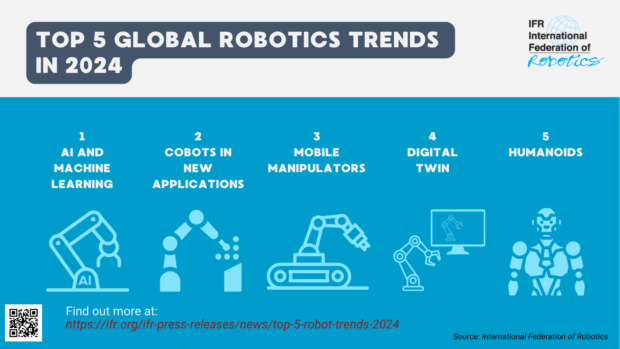Artificial intelligence is opening the door to increased use of robotics in a variety of industries, according to the International Federation of Robotics.
“The five mutually reinforcing automation trends in 2024 show that robotics is a multidisciplinary field where technologies are converging to create intelligent solutions for a wide range of tasks,” said Marina Bill, president of the International Federation of Robotics. “These advances continue to shape the merging industrial and service robotics sectors and the future of work.”
1. Artificial Intelligence (AI) and machine learning
Robot manufacturers are developing generative AI-driven interfaces allowing users the ability to program robots more intuitively by using natural language instead of code. As a result, employees won’t need specialized programming skills to control a robot’s actions.
Predictive maintenance is another example of how manufacturers can save machine downtime costs, the association outlined.
As an example, each hour of unplanned downtime in the automotive parts industry is estimated to cost $1.3 million, according to the Information Technology & Innovation Foundation.
Machine learning algorithms can be used to analyze data from multiple robots performing the same process to enhance optimization.
In general, the more data a machine learning algorithm is given, the better it performs, the IFR said.
2. Cobots expanding to new applications
Human-robot collaboration continues to be a major trend in robotics.
Advances in sensors, vision technology and smart grippers allow robots to respond in real-time to changes in their environment, optimizing safety while working alongside human employees.
Collaborative robot applications offer a new tool for human workers, relieving and supporting them. They can assist with tasks that require heavy lifting, repetitive motions or work in dangerous environments, the association said.
Collaborative robots are expected to complement, not replace, traditional industrial robots “which operate at much faster speeds and will therefore remain important for improving productivity in response to tight product margins.”
Mobile manipulators, the combination of collaborative robot arms and mobile robots (AMRs), offer new use cases that could expand the demand for collaborative robots substantially, the IFR stated.
3. Mobile manipulators
Mobile manipulators , or “MoMas,” are automating material handling tasks in industries such as automotive, logistics and aerospace.
They combine the mobility of robotic platforms with the dexterity of manipulator arms, enabling them to navigate complex environments and manipulate objects, crucial for applications in manufacturing, the IFR said.
Equipped with sensors and cameras, the robots perform inspections and carry out maintenance tasks on machinery and equipment.
A significant advantages of mobile manipulators is their ability to collaborate and support human workers, the IFR stated.
4. Digital twins
Digital twin technology is being used as a tool to optimize the performance of a physical system by creating a virtual replica.
Digital twin robots can use their real-world operational data to run simulations and predict likely outcomes.
According to the IFR, because the twin exists purely as a computer model, bridging the gap between the physical and digital world, it can be stress-tested and modified with no safety implications while saving costs.
5. Humanoid robots
Robotics is witnessing significant advancements in humanoids, designed to perform a wide range of tasks in various environments. The human-like design with two arms and two legs allows the robot to be used flexibly in work environments that were actually created for humans. It can therefore be easily integrated e.g. into existing warehouse processes and infrastructure.





















 Examining 5 Key Factors Fueling MGA Growth—and Emerging Challenges Ahead
Examining 5 Key Factors Fueling MGA Growth—and Emerging Challenges Ahead  Legal Finance and Insurance: From Confusion to Collaboration
Legal Finance and Insurance: From Confusion to Collaboration  How Carriers Are Pairing AI and Process Discipline to Drive Subrogation Outcomes
How Carriers Are Pairing AI and Process Discipline to Drive Subrogation Outcomes  AI in Property/Casualty Insurance: Why Trusted Data Is the Missing Link
AI in Property/Casualty Insurance: Why Trusted Data Is the Missing Link 